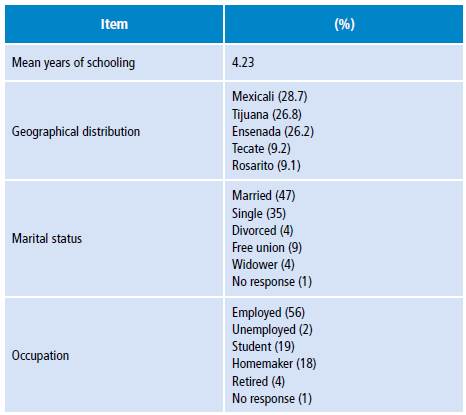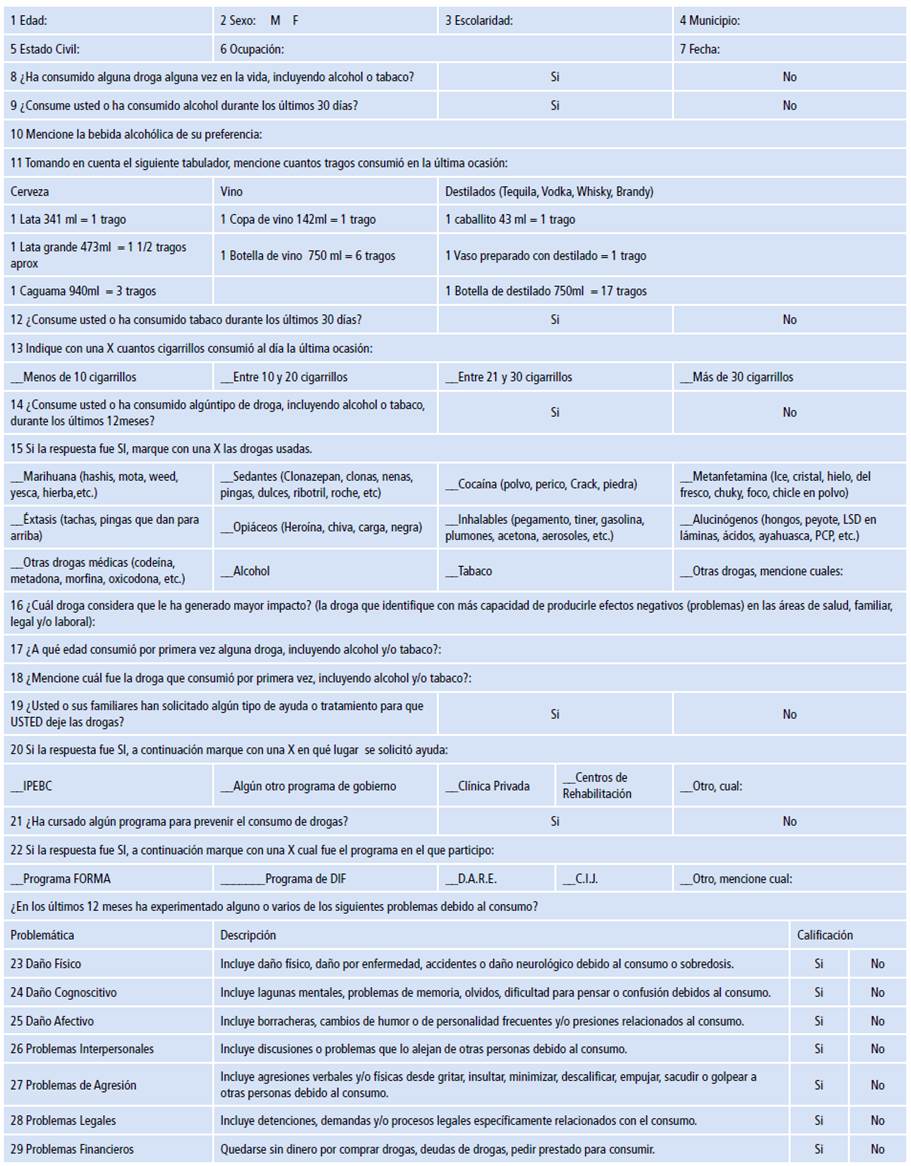Introduction
In Mexico, as in other countries 1, the most commonly abused drugs include cannabis, opiates, cocaine, amphetamines, methamphetamines, and some of their derivatives. Other than their general neuropathological effects, little is known regarding the direct effects of these drugs on the central nervous system in humans 2, mainly due to different ethical and procedural issues and the fact that drug use habits change constantly among population groups.
Drug abuse can be defined as the continuous use of drugs despite the negative effects associated with their consumption. 3 Diagnosing drug addiction or clinically determining that a person has drug abuse problems is a complex and challenging task due to several factors, including patients' cooperation level (i.e., whether they are willing to share information on their drug consumption habits). 4 Nevertheless, drug abuse screening tests (DAST) have proven to be highly valid and reliable in population groups with psychiatric disorders and substance use disorders. Likewise, surveys on illegal drug use annual trends conducted in large population groups are useful for providing data on drug abuse rates and trends and on drug use-related morbidity, such as information regarding the evolution of drug abuse-related cognitive impairment. 5
Furthermore, drug use screening inventories have proven to be useful for identifying drug abuse during youth, the level of drug involvement, and its correlation with the development of medical conditions. For example, based on data obtained from DUTSs, it has been reported that increased levels of alcohol consumption are associated with the development of social, behavioral, academic and emotional problems 6; antisocial behavior in adolescence; specific personality organization, and drug preferences. 7,8
Usually, two or more research instruments are used when studying drug consumption and drug use-related disorders 9, since this methodology allows a more specific identification of behavior personality traits or psychopathologies according to the personality organization of each individual and its relation with their drug consumption characteristics. For example, in the case of cognitive impairment, one instrument is specifically used to analyze the drug under study, while another instrument or multiple instruments are used to analyze cognitive performance. 10-12
Carey et al.13, based on data obtained from brain hypoactivity functional magnetic resonance imaging (fMRI) tests, reported that in the case of cannabis abuse, a significant error-processing dysfunction was found in the dorsal anterior cingulate cortex, which in turn could lead to the inability to adapt to new situations and learn from errors.
Likewise, evidence suggests that drug abuse has a direct impact on complex cognitive processes, such as those related to drug-associated (conditioned) stimuli-related behavioral control, as described by Jentsch & Taylor 14, who analyzed frontostriatal dysfunction in drug abuse via animal models and suggested that chronic use of psychoactive substances may cause dopaminergic hypofunction, which may be associated with loss of inhibition with respect to reward-seeking behaviors and accompanied by increased susceptibility to stress-induced relapse. However, implementing these diagnostic techniques in Mexican population in order to manage and treat drug use-related cognitive dysfunction remains a challenge, since currently they are too expensive.
Drug trend studies on cognitive dysfunction that are based on screening tests have shown that these tests reduce costs; also, these studies have reported the strengths and limitations of using screening tests as a complementary technique to identify whether comprehensive neuropsychological assessment is required or not. 15-17 Likewise, screening tests provide a brief administration monitoring tool that could be of great help for measuring cognitive impairment in drug users. 18
Similar to the present work, Villalobos et al.19 conducted a DAST study with a reliability assessment using a self-report questionnaire in order to assess the psychometric and diagnostic properties of a drug abuse screening test, in which they found that the instrument had sufficient internal consistency compared to other screening tests. However, they concluded that more studies are needed to determine the applicability of the test and to properly evaluate its psychometric and diagnostic properties.
Considering the above, the objectives of the present study were to validate a drug DAST and to describe the association between using and abusing drugs and the development of cognitive dysfunction in a population from the border area of northwest Mexico.
Materials and methods
Taking the proposed objectives into account, an internal consistency reliability test was applied to all the items of the DAST 20, and a descriptive-correlational design was used.
Participants
The population study consisted of 1299 individuals from 5 cities located in Baja California, Mexico, of which 52% were women. The average age was 39.25 years (SD=17.4). Participants were distributed and clustered by age, sociodemographic characteristics, and location (Table 1) after they voluntarily agreed to participate in the study.
The study was approved by the Bioethics Committee of the Institute of Psychiatry of the State of Baja California (IPSBC), a member of the National Bioethics Committee, under code CONBIOETICA02CEI01020150416, as stated in Minutes DFA/Voo/ CEI/01172015 of April 16, 2015, and was classified as a minimum risk study that did not require participants to sign informed consent forms according to the Mexican General Health Law. 21 Likewise, the ethical principles for medical research involving human subjects established in the WMA Declaration of Helsinki were followed 22, and measures to ensure participants' confidentiality were implemented.
Instrument
A DAST (Annex 1 ) developed by the research team and not intended for self-administration was used to obtain the study population's drug abuse trends and to analyze the correlation between drug abuse and the development of clinical conditions. The instrument is composed of 29 self-report items, which were created based on clinical markers 23 and divided into five categories: a) demographics b) alcohol consumption, c) tobacco consumption, d) use of other drugs, and e) drug use-related disorders. The questions of the DAST cover information on doses, the different names widely used to refer to each drug, and examples of drug use-related disorders. The survey administration time ranges from 10 to 15 minutes, and it can be administered in different environments.
Procedure
The survey was administered by the Research Department of the IPEBC. Ninety-three psychologists and 11 social workers from the Comprehensive Program against Drug Addiction (Programa de Prevención contra las Adicciones) of the IPEBC were trained to ensure the proper administration of the instrument to all participants. Home visits were made from January to March 2016 to directly assess the responses provided by each participant.
Data analysis
Pearson correlation coefficient parametric tests were applied to analyze the data obtained from the responses provided by participants who reported having cognitive impairment and using any of 10 different types of drugs, namely, alcohol, tobacco, marijuana, ecstasy, over-the-counter drugs (codeine, methadone, morphine, oxycodone, etc.), opiates, cocaine, inhalants, methamphetamines, and hallucinogens. Correlation analyses were also carried out in order to measure associations between the different types of drugs consumed. Finally, the chi-square test was used to compare the proportions of participants who, on the one hand, reported alcohol consumption, and, on the other, cognitive impairment.
Results
Results are presented in two sections: first, those regarding the DAST reliability test, and second, those regarding the association between reported cognitive impairment and consumption of a specific type of drug and the interaction between the different types of drugs consumed by participants.
Reliability test
The Kuder-Richardson Formula 20 (KR-20) test was used to measure the internal consistency reliability of all the nominal and ordinal items of the instrument. For 30 items (ru=0.859), a high internal consistency value was obtained when the instrument was assessed as a whole. Similar results were found for each item when individually analyzed (ru>0.859).
Reported cognitive impairment and drug use
The Kolmogorov-Smirnov normality test showed that cognitive dysfunction did not have a normal distribution in the sample (DF (Degrees of freedom)=1084, p<001) from the total sample. Only 77 participants (5.9%) reported having or having experienced 20 H cognitive impairment. The percentage distribution of drug use among participants per drug type is shown in Table 2, only 56.8 % of the sample reported drugs consumption.
Table 2 Drug use percentage distribution in the sample.
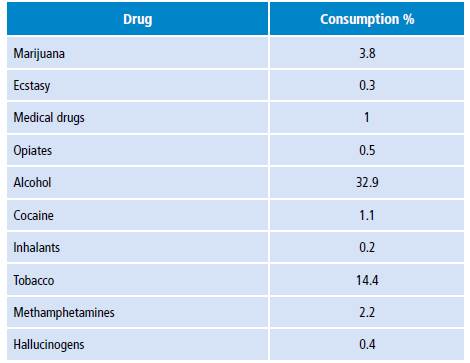
Source: own elaboration based on the data obtained in the study.
A Yates's chi-squared test was conducted to determine significant differences between the proportions of participants who reported cognitive impairment according to the type of drug they used. Somehow, due to the consumption proportions obtained per type of drug and the chi-square limitation rule of thumb (i.e., if (i) an expected value in a cell is less than 5 or (ii) more than 20% of the expected values in the cells are less than 5, then the chi-square value should not be and usually is not computed), this analysis was possible only for alcohol and tobacco use, which is in line with the expected distribution of drug use per type of drug in Mexican populations according to previous reports. (24) The differences between the proportions of participants with cognitive impairment (n=77) who reported alcohol (X2=28.089,DF=l,p0.001)and tobacco (X2=51.377,DF=l,p0.001) consumption and those who did not are shown in Figures 1 and 2.
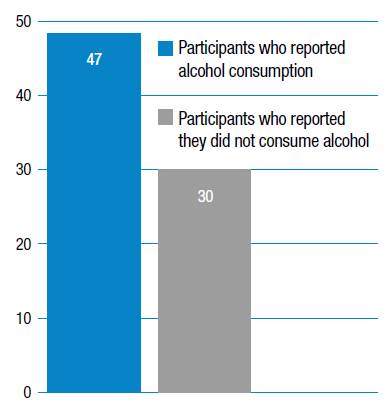
Source: own elaboration based on the data obtained in the study.
Figure 1 Distribution of participants with cognitive impairment between participants who reported alcohol consumption and participants who reported they did not consume alcohol.
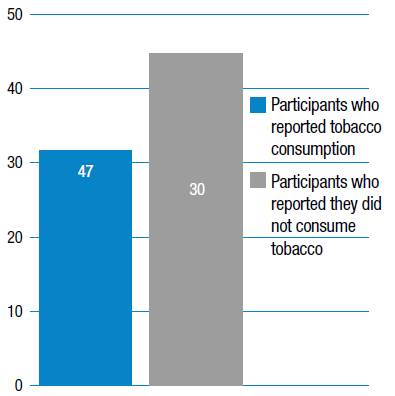
Source: own elaboration based on the data obtained in the study.
Figure 2 Distribution of participants with cognitive impairment in terms of tobacco consumption
The drug consumption correlation analysis showed a significant positive interaction between drugs (Table 3). Most of the subjects who reported having consumed at least one type of drug also reported the use of one or more other drugs. In this sense, the following positive correlations were found: marijuana consumption with methamphetamine consumption; ecstasy consumption with hallucinogen and over-the-counter drug consumption; over-the-counter drug consumption with opiates, cocaine, and inhalant consumption, and inhalant consumption with methamphetamine consumption.
Table 3 Drug consumption correlation matrix.
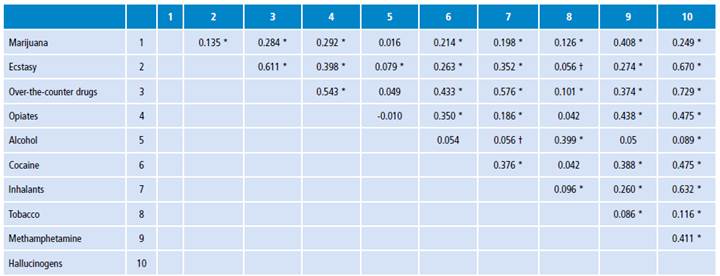
*p<0.01.
† p<0.05.
Source: own elaboration based on the data obtained in the study.
Furthermore, it was found that the age at which drug consumption started could be used to identify cognitive dysfunction, since according to the correlation analysis, age at first drug use and reported cognitive impairment were po sitively correlated (rP=0.107,p<0.001). However, age at first drug use and reported affective damage were inversely correlated (rP=-0.152, pO.001).
Discussion
The use of screening tests to study drug abuse trends in large populations has several advantages. For example, on the one hand, due to their short administration time, the use of these tests in this population is easier, since it is widely known that retaining drug users for long periods of time (hours) is a challenge, and, on the other, these tests can be used to obtain multidisciplinary information about different aspects, such as reported cognitive dysfunction and drug consumption correlations.
Several studies have described how brief administration instruments not specifically designed to assess drug consumption have allowed identifying associations between cognitive impairment and drug use. For example, in the case of alcohol consumption, Marceau et al.11 indicate that the Montreal Cognitive Assessment (MoCA) instrument, a specific brief administration screening test, has high sensitivity regarding the detection of alcohol use-related cognitive impairment. Usually, alcoholics have difficulty recognizing their cognitive deficits: when the efficiency of higher-order cognitive processes is affected, cognitive dysfunction self-awareness is reduced 25; this might explain why only 77 of the f 299 participants included in the present study reported having cognitive impairment.
There are several studies reporting that DASTs psychometric properties are excellent. 26,27 Likewise, these tests have been proven to have excellent predictive power and high internal consistency levels across different psychiatric disorders in clinically unstable samples. 4,28. In the case of the DAST used here, its psychometric properties indicate that in the potentially small proportion of participants who reported having cognitive impairment, a significant number of them also reported alcohol consumption. Further studies should be conducted to better understand the low proportion of cognitive impairment related to the use of other drugs in screening tests such as the one used here.
The results obtained here evidence a low to moderate drug abuse trend in the screened sample. Compared to other studies on drug abuse trends in the Mexican population on a nationwide level, such as the one conducted by Villatoro et al.24, a higher percentage of alcohol consumption (32.9% vs 11.1%) was found, yet for marijuana, inhalant and cocaine consumption, the percentages were significantly lower: 3.8% vs 9.4%, 0.2% vs. 3.7, and 1.1% vs. 2.5%, respectively.
In addition, a drug correlation analysis could play a fundamental role both in the detection of other medical conditions 8 or psychological disorders, such as suicidal behaviors 29, and in the prediction of the consumption of other types of drugs. 30 Furthermore, as suggested by other studies, DASTs could be used to measure the side effects of psychotropic medications 31 or could be used in non-clinical environments. 32
The present study shows that the instrument is sensitive to detecting drug consumption interactions and cognitive dysfunction correlations, particularly in alcohol users. However, although screening tests may be sensitive to detecting an association between drug abuse and cognitive dysfunction, they should not be used as a replacement for neuropsychological assessment tests 15; instead, they should be used to identify individuals that may require neuropsychological assessment.
In addition, considering the controversy surrounding the correlations between drug consumption and cognitive impairment reported in Mexico 33, future studies on drug abuse in large populations should consider additional factors, such as gender 34 age at first use and stage of life 35, and dismiss confusing factors such as drugs availability 36.
Conclusions
DASTs allow the performance of both statistical and multidisciplinary health analyses that in turn lead to the development of less expensive alternatives for studying drug users. Diagnosing cognitive dysfunction requires a costly clinical analysis method that cannot be conducted in more than one individual at the same time, so the instrument tested here could offer a less expensive option and a better understanding of the possible interactions between using certain types of drugs and cognitive dysfunction prevalence in large populations. Likewise, DASTs offer a better understanding of the significant correlations between the consumption of different drugs, which could provide more knowledge on drug addiction behaviors in populations inhabiting specific areas.
As mentioned before, the DAST used here constitutes a less expensive instrument, both in economic and human resources terms, for conducting national studies on drug abuse trends; thus, it could serve as a reliable model for developing new DASTs to be used in future studies. Currently, thanks to modern technologies and highly reliable statistical analysis software programs, human and economic resources can be maximized even when analyzing drug abuse trends in remote populations; this ability, in the case of Mexico, could greatly contribute to the development of a nationwide drug abuse trend study.
Future studies on drug abuse in large populations should consider including the age at first drug use (per drug type) as an analytical variable.













